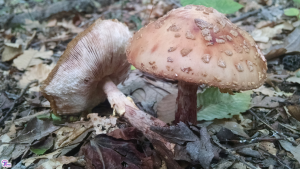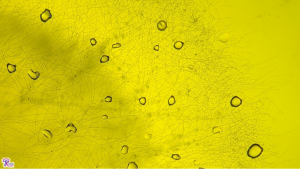#155: Microglossum viride, the Green Earth Tongue
This is probably one of the most difficult fungi to find in North America. It is not a common mushroom, but its occurrence may be underreported thanks to its small size and green colors. These traits mean that Microglossum viride is particularly adept at blending in with its mossy surroundings. However, its unmistakably green coloration means it is very easy to identify the “Green Earth Tongue” once you have found it.
M. viride is an earth tongue, placing it in a morphological group of mushrooms that look somewhat like tiny tongues growing from the ground (Microglossum actually means “tiny tongue”). As with other earth tongues, M. viride has a clearly differentiated head and stipe. The head is tongue-shaped and produces spores while the stipe is cylindrical and serves only to hold up the head. This entire structure is quite small, growing only 1-5cm (0.4-2in) tall and 1-6mm (0.04-0.2in) wide.
Although the head of an earth tongue is supposed to look like a tongue, I think it looks more like a cardboard tube that has been pinched in on each side running the length of the tube. If you try that, you will end up with a somewhat flattened figure-eight shape. Likewise, the head of M. viride is shaped roughly like a flattened cylinder with a groove running up the center of each side. It grows 6-26mm tall and 1-6mm wide and usually – but not always – makes up the bulk of the mushroom. The head is almost always lumpy or warped in some way to make it look rather irregular. It is usually widest toward the middle and often comes to a point at the top. Unlike other earth tongues, the head of M. viride is colored green, ranging from bright green to dull green. Certain other earth tongues have green tones but are primarily black or brown in color. The predominantly green coloration in the Green Earth Tongue makes it unmistakable.
The stipe of M. viride is cylindrical in shape and is often curved to make the head stand roughly vertical. It grows 9-21mm tall and 1-3mm wide. In the Green Earth Tongue, it is very easy to differentiate the head from the stipe thanks to the stipe’s distinctly scaly texture. The surface of the stipe is pale to light green, but the darker scales make it appear about the same color as the head. As the mushroom ages, the scales may fall off and the stipe may take on a darker hue.
M. viride grows in moss or tree litter underneath both hardwoods and conifers. It is widely distributed in both North America and Europe, but is not common on either continent. In most areas, the Green Earth Tongue fruits during the summer and fall. However, in warmer climates such as California, it is usually found in winter or spring.
There is one look-alike to the Green Earth Tongue that was lumped in with M. viride until DNA evidence teased it out in 2014. M. griseoviride is found in Europe, is grayish green in color, forms thinner asci (spore-producing cells), and produces spores that are just a bit smaller. This species has been found only in Europe, so North American mushroom hunters won’t have to worry about subjective color differences while identifying M. viride.
Earth tongues are ascomycetes, meaning they produce spores inside long, sac-like cells. However, their microscopic similarities end there. The earth tongues are a morphological group, which means they are not necessarily related to one another evolutionarily. Most earth tongues are placed in the family Geoglossaceae, which has been assigned to neither a class nor an order. Microglossum has been separated from this core group and assigned to the family Leotiaceae, which includes Leotia lubrica (the Jelly Baby, which is so named for its squishy, irregularly spherical head). The Green Earth Tongue is placed in the phylum Ascomycota, class Leotiomycetes, order Leotiales, and family Leotiaceae.
See Further:
http://www.mushroomexpert.com/microglossum_viride.html
http://www.mykoweb.com/CAF/species/Microglossum_viride.html
http://www.rogersmushrooms.com/gallery/DisplayBlock~bid~6420.asp







![#011: Characteristics of Kingdom Fungi [Archived]](https://www.fungusfactfriday.com/wp-content/themes/hueman/assets/front/img/thumb-small-empty.png)


